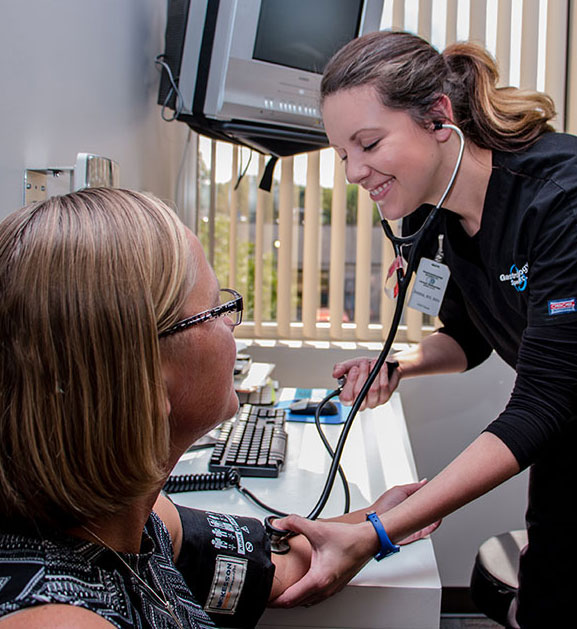To help you understand and manage your condition, the AGA Institute provides you with the following information, designed to give you some basic facts, to help you better understand your condition and to serve as a starting point for discussions with your doctor.
Disease Basics
- Celiac disease is an autoimmune disorder that causes your immune system to interfere with the proper function of the small intestine.
- There is no known cause of celiac disease. It is believed to be a genetic disorder, or something you were born with; however, once developed, symptoms can range from infancy to adulthood.
- Celiac disease is considered a malabsorption disease because it prevents the body from collecting nutrients as food passes through the small intestine.
- Although the disease can be tricky to diagnose, treatment is straightforward and relief of symptoms generally begins within days or weeks of adopting a gluten-free diet.
Introduction
While you may initially be relieved to receive a diagnosis for the unexplained symptoms you may have been experiencing, you may also be scared by hearing you have celiac disease. It is important to know that by working with your gastroenterologist and dietitian, you can develop a medical and nutrition management plan that can help control your symptoms and may reverse the damage of your disease, allowing you and your loved ones to live healthy lives.
Celiac disease occurs in the digestive system when people cannot tolerate a protein called gluten. Gluten is found primarily in wheat, barley and rye, but may also be in products you use every day, such as soy sauce and salad dressing, as well as some medications and vitamins.
Celiac disease was, until recently, thought to be a rare disease. However, recent research has shown that as many as three million people in the U.S. may have celiac disease. It is very common among first-degree relatives of people who have celiac disease, including siblings, parents and children, meaning it is a genetic disease. Celiac disease can be diagnosed in both children and adults and people may live for years without knowing they have it. In some patients with the genetic predisposition, the disease reveals itself after an event such as surgery, pregnancy, viral infections or severe emotional stress.
Many people living with celiac disease are undiagnosed for a number of reasons:
- The symptoms associated with celiac disease are often attributed to other problems.
- While many health-care providers have learned about the disease, they may not think first about celiac disease as a potential diagnosis when presented with the list of symptoms.
Biology of Celiac Disease
Celiac disease causes your immune system to damage the lining of the small intestine, the section of your gastrointestinal tract between the stomach and the large intestine.
The small intestine, which is about 20 feet long, finishes the process of digestion, absorbs the nutrients and passes the residue on to the large intestine. The small intestine is lined by tiny, fingerlike protrusions, called villi. These normally allow nutrients from food to be absorbed into the bloodstream. Without healthy villi, nutrients will pass through the small intestine without being absorbed, and you may become malnourished.
Celiac disease is a life-long disease. It is classified as both an autoimmune disorder, because the body is damaged by its own immune system, and a disease of malabsorption, since your body cannot absorb the nutrients it needs to function properly.
With celiac disease, when you eat foods or use products containing gluten, your immune system responds by damaging cells and destroying the villi lining the small intestine. However, if you change your habits and adopt a gluten-free lifestyle, you can reverse the damage associated with celiac disease.
Symptoms
Celiac disease affects people differently and the symptoms are wide and varied. Experiencing these symptoms does not mean you have celiac disease, just as some patients with the disease may not show any symptoms. However, if you have one or more of these symptoms or a relative with celiac disease, you may want to talk to your gastroenterologist about getting tested.
- Gas, recurring abdominal bloating and pain
- Chronic diarrhea or constipation; pale, foul-smelling or fatty stool
- Weight loss/weight gain
- Fatigue
- Unexplained anemia (a low count of red blood cells causing fatigue)
- Behavioral changes; irritability is common in children
- Tingling numbness in the legs (from nerve damage)
- Bone or joint pain
- Muscle cramps
- Delayed growth in children or failure to thrive in infants
- Pale sores inside the mouth, called aphthous ulcers
- Itchy skin rash called dermatitis herpetiformis
- Osteoporosis, especially at a young age
- Low iron levels
Diagnosing Celiac Disease
Since the symptoms of celiac disease often mimic other diseases, such as irritable bowel syndrome, Crohn’s disease and diverticulitis, it is often difficult to recognize whether you may have the disease. In discussing your symptoms with your gastroenterologist, he or she may order a blood test to determine whether you have high levels of autoantibodies, which are antibodies that react to your own body’s tissues.
If the blood test comes back positive, your gastroenterologist may perform an endoscopy to obtain a sample of the tissue (biopsy) from your small intestine to test the damage to the villi. An endoscopy is performed by your gastroenterologist using a long, thin, flexible tube with a tiny video camera and light on the end. The gastroenterologist can safely guide the instrument to carefully examine the inside lining of the small intestine. Tiny instruments are passed through an opening in the endoscope to obtain tissue samples for the biopsy.
The biopsies and blood tests can return to normal on a gluten-free diet. If you think you may have celiac disease, do not eliminate gluten from your diet until you have been tested by your doctor.
Treatment
The primary treatment for celiac disease is the strict following of a gluten-free diet. A life-long gluten-free diet will help protect your small intestine.
In many patients with celiac disease, even a small amount of gluten is enough to cause intestinal damage, even though you may not be experiencing symptoms.
While you may be tempted to cheat, and may not notice much of a problem when you do, it is important to remember that you may run the risk of long-term problems.
Good news: Improvements in symptoms should begin within days of changing your diet.
While you will never be completely cured of celiac disease, after adopting a gluten-free diet your small intestine should heal in two years for adults and within a few months in children and young adults.
Your gastroenterologist may want to take an intestinal tissue biopsy about six months after diagnosis to confirm your new diet is helping to improve the intestinal tissues.
Being healed from celiac disease means that your small intestine returns to normal function and can begin absorbing nutrients properly; however, it does not mean that you can stop eating gluten-free products. Some patients with celiac disease may experience symptoms if the same cookware is used to cook their food and food containing gluten.
Complications of Celiac Disease
- Due to damage of the small intestine and nutrient absorption problems, people with celiac disease are at increased risk of developing malnutrition, anemia and other diseases and health problems.
- Patients with celiac disease may develop osteoporosis (weak and brittle bones) or short stature in children. This is due to lack of nutritional absorption.
- Some patients with celiac disease may have other autoimmune disorders including type 1 diabetes, thyroid disease, rheumatoid arthritis and liver disease, among others.
- After years of being undiagnosed, a very small percentage of adults with celiac disease may experience “refractory” celiac disease, which means that the body does not respond to a gluten-free diet and that symptoms continue and can lead to intestinal damage. This can sometimes be triggered by going off a gluten-free diet.
- Patients may experience an increased risk of lymphoma and intestinal cancers.
- Much research is being conducted on celiac disease to increase understanding and awareness that will lead to earlier diagnosis and treatment of the disease.
A Gluten-Free Diet
Grains, including wheat products, are a major source of nutrients in the basic American diet. The U.S. Department of Agriculture recommends individuals eat between three and eight ounces of grains a day depending on age and activity level. For instance, this is one slice of bread, one cup of ready-to-eat cereal, or a half a cup of cooked rice, cooked pasta or cooked cereal.
Once you are diagnosed with celiac disease, your gastroenterologist and dietitian will work with you to help develop a diet program that will be free of gluten-containing products, but still ensure you are receiving the correct balance of nutrients. You will need to learn how to read nutrition labels to ensure that the products do not contain gluten or other ingredients that may affect you. While the introduction of a gluten-free diet can seem overwhelming, especially for a child, there are many foods that can be substituted for traditional wheat-based foods.
Some foods you will be allowed to eat include:
- Amaranth.
- Arrowroot
- Brown rice
- Buckwheat
- Corn
- Flax
- Legumes
- Millet
- Nuts
- Potatoes
- Quinoa
- Seeds
- Sorghum
- Soy
- Tapioca
- Teff
- Wild Rice
Foods to avoid include:
- Wheat, including durum, graham, spelt, kamut, semolina.
- Wheat starch, wheat bran, wheat germ, cracked wheat, hydrolyzed wheat protein.
- Barley.
- Rye.
- Triticale (a cross between wheat and rye).
- Malt (unless derived from corn).
Many products thought to be gluten-free are often contaminated with gluten, such as oat products. For this reason oats are not allowed in the initial diets of those with celiac disease. Gluten free oats from a dedicated facility can later be introduced under the supervision of a physician or dietitian.
There are many processed food products that are made using wheat, barley and rye. While many of these products are available gluten-free, read the nutrition label or contact the manufacturer to learn more.
- Bouillon cubes
- Broths
- Chips/potato chips
- Candy
- Cold cuts, hot dogs, salami, sausage
- Communion wafers
- French fries
- Gravy
- Matzo
- Rice mixes
- Sauces
- Seasoned tortilla chips
- Self-basting turkey
- Soups
- Soy sauce
Adapted from Thompson T. Celiac Disease Nutrition Guide, 2nd ed. Chicago: American Dietetic Association; 2006. © American Dietetic Association; and Quick Start Guide for Celiac Disease, Celiac Disease Foundation and the Gluten Intolerance Group. For a complete copy of the Celiac Disease Nutrition Guide, please visit www.eatright.org.
NIH Publication No. 06–4269, October 2005; NIH Consensus Development Conference Statement on Celiac Disease, June 28-30, 2004. Gastroenterology:128;4:S1-S9.


